When it comes to regaining independence, a wheelchair joystick allows you the maximum freedom of a complex rehab chair. You deserve the ease and comfort that the right joystick can provide to help improve your quality of life.
You might be surprised to know that there are a lot of choices when it comes to joysticks. There are also many other aspects that you need to think about when making a choice.
If you’re not sure where to start, then we’ve taken the guesswork out of your decision. Here is a complete guide to wheelchair joysticks and how they work with your complex rehab chair.
What is a Wheelchair Joystick?
There are a number of controls used to maneuver a power wheelchair. A joystick is known as proportional control. This is the most commonly used type of control.
The joystick moves the powered wheelchair in the direction that the user points it in. Typically, the further the joystick is pushed, the faster the power wheelchair will go.
When you release the joystick, this automatically applies the brakes. The powered wheelchair will then stop.
Non-proportional controls are an option for those individuals who may not be able to use a joystick. These include switches, head arrays, scanners, buttons, and sip/puff options.
Digital Display
Since the invention of The Klein Chair back in the 1950s, the electric motor-powered wheelchair has come a long way.
There are many different types of joysticks to consider, and one aspect is the digital display. First, you should try out the different digital displays and see if it’s right for you. Some find them distracting and prefer not to have one at all.
Others enjoy the details that a digital display provides but may prefer a larger screen that is easier to read. There are also lighting options that you should test before settling on one particular type of screen.
Additional aspects of the joystick’s technology include sounds. Some may find the tones and noises helpful, while others may not. It’s all a matter of preference.
Complex Technology
Today’s modern complex rehab chairs offer a wide range of technological advancements. However, the amount of bells and whistles it will have depends on your preferences.
Some wheelchair joysticks come with Bluetooth embedded in the handle. This allows you to control a number of other Bluetooth devices right from the convenience of your chair. This could include a mobile phone or tablet that you can turn on or receive notifications from.
You can find large joystick displays that have screens to control things like TVs, DVD players, as well as environmental controls within your home.
Deciding how intricate and customizable you want your joystick to be is all about personal preference. Some users prefer to keep their joystick simple. Although it’s nice to know you have options.
Location, Location, Location
When it comes to the joystick, picking the placement of the controls is an important aspect. This is because it can affect an individual’s posture, and also determine how comfortable they are in their chair.
For this reason, there are many options for mounting a joystick. The location can assist in a person being able to use the joystick. For example, some might be mounted on a small table that sits across the front of the person.
This can provide the extra support needed for their upper body. Other mounted joysticks can be installed to the left or right of the individual and swing away when necessary.
Furthermore, the angling of the joystick can provide accommodation for those who have a postural deformity or extremity contracture. The great thing is that each aspect can be catered to your individual needs.
A Joystick You Can Handle
Choosing the right joystick for you means finding an option that is comfortable. That’s why there are a number of different handle designs. You’ll find options such as a small ball, T-handle, and goal post style, among others.
Depending on the individual, some joystick handles are easier to maneuver than others. Many complex rehab chairs come with a variety of handles to choose from. You may also be able to custom order a specific handle to meet your needs.
There are additional controllers, such as the head arrays, which allow the user to control their chair using head movements. These options allow for a wide range of chair users to gain new independence.
Customizable Programming
In addition to choosing the physical appearance and function of a joystick, there are also some aspects that can be programmed to your specific preferences. For example, the amount of force you need to exert to engage the wheelchair can be adjusted.
This can be helpful to keep things like tremors from activating the wheelchair accidentally. Also, the direction assignment and alarms can be programmed to suit the individual. This can make it easier for someone to get comfortable with their new joystick.
Get Your Wheelchair Joystick
Deciding which wheelchair joystick is right for you is not only about preference, but also its functionality. How do you need your joystick to be mounted? What technology will you need in order to complete daily tasks?
Plus, you should take your comfort into consideration. Since you will need to reach for your joystick often, the placement is going to be a key part of its design.
We hope this guide to the different types of joysticks for your complex rehab chair will help you with the decision-making process. As always, we are here to help you every step of the way. We serve all of North Carolina, South Carolina, and Georgia.
Looking for more helpful advice on complex rehab chairs and beyond? Check out our blog for your best source for mobility news.

